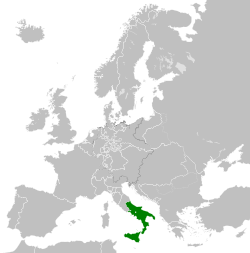Kingdom of Naples and Sicily
| Kingdom of the Two Sicilies | ||||||||||||
| Regno delle Due Sicilie | ||||||||||||
|
||||||||||||
|
||||||||||||
|
Anthem Inno al Re (Hymn to the King) |
||||||||||||
|
Location of the Kingdom of the Two Sicilies within Europe in 1839.
|
||||||||||||
| Capital |
Naples (1808–16; 1817–61) Palermo (1816–1817) |
|||||||||||
| Languages | Italian, Sicilian, Neapolitan | |||||||||||
| Religion | Roman Catholicism | |||||||||||
| Government |
Absolute monarchy (1808–1848; 1849–1861) Constitutional monarchy (1848–1849) |
|||||||||||
| King | ||||||||||||
| • | 1808–1815 | Joachim I (first) | ||||||||||
| • | 1859–1861 | Francis II (last) | ||||||||||
| History | ||||||||||||
| • | Edict of Bayonne | 1808 | ||||||||||
| • | Battle of Tolentino | 2 May 1815 | ||||||||||
| • | Bourbon Restoration | 22 May 1815 | ||||||||||
| • | Expedition of the Thousand | 1861 | ||||||||||
| Area | ||||||||||||
| • | 1860 | 111,900 km2 (43,200 sq mi) | ||||||||||
| Population | ||||||||||||
| • | 1860 est. | 8,703,000 | ||||||||||
| Density | 78/km2 (201/sq mi) | |||||||||||
| Currency | Two Sicilies ducat | |||||||||||
|
||||||||||||
| Today part of |
|
|||||||||||
The Kingdom of the Two Sicilies (Neapolitan: Regno d''e Ddoje Sicilie, Sicilian: Regnu dî Dui Sicili, Italian: Regno delle Due Sicilie) was the largest of the states of Italy before the Italian unification. It was formed as a union of the Kingdom of Sicily and the Kingdom of Naples, which collectively had long been called the "Two Sicilies" (Utraque Sicilia, literally "both Sicilies").
The Kingdom of the Two Sicilies lasted from 1815 until 1860, when it was annexed by the Kingdom of Sardinia to form the Kingdom of Italy in 1861. The capitals of the Two Sicilies were in Naples and in Palermo. The kingdom extended over the Mezzogiorno (the southern part of mainland Italy) and the island of Sicily. Jordan Lancaster notes that the integration of the Kingdom of the Two Sicilies into the Kingdom of Italy changed the status of Naples forever: "Abject poverty meant that, throughout Naples and Southern Italy, thousands decided to leave in search of a better future." Many went to the United States, Australia and Argentina. The kingdom was heavily agricultural, like the other Italian states; the church owned 50–65% of the land by 1750.
The name "Two Sicilies" originated from the partition of the medieval Kingdom of Sicily. Until 1285, the island of Sicily and the Mezzogiorno were constituent parts of the Kingdom of Sicily. As a result of the War of the Sicilian Vespers (1282-1302), the King of Sicily lost the Island of Sicily (also called Trinacria) to the Crown of Aragon, but remained ruler over the peninsular part of the realm. Although his territory became known officially as the Kingdom of Naples, he and his successors never gave up the title "King of Sicily" and still officially referred to their realm as the "Kingdom of Sicily". At the same time, the Aragonese rulers of the Island of Sicily also called their realm the "Kingdom of Sicily". Thus, there were two kingdoms formally called "Sicily": hence, the Two Sicilies.
...
Wikipedia



